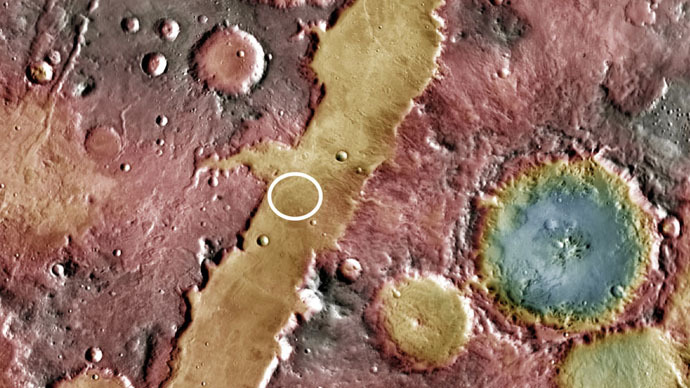Impact glass found on Mars may be key to discovering life, scientists say

By using NASA’s Mars satellite data, researchers found impact glass deposits on the Red Planet that could have preserved signatures of life.
The study led by Kevin Cannon, a Ph.D. student at Brown University, Providence, Rhode Island, and Jack Mustard, a professor of earth, environmental and planetary sciences at Brown, shows that significant impact glass deposits are present in several ancient albeit well-preserved craters on Mars.
READ MORE: NASA finally launches flying saucer-like prototype to edge of space
The results of their study were published in the journal Geology on June 5.
Impact glass is created as a result of high temperature impact on rock formations engendered by a meteorite crashing into a planet’s surface.
Research in 2014 led by Professor Peter Shultz of Brown University proved that such glass may contain organic molecules or even organic debris.
During his work in Argentina, Shultz found organic molecules along with plant matter in an impact glass formed by a meteorite fall millions of years ago.
“The work done by Peter Shultz and others showed us that glasses are potentially important for preserving bio signatures. Knowing that, we wanted to go look for them on Mars and that’s what we did here. Before this paper, no one had been able to definitively detect them on the surface,” Cannon said in a statement.
READ MORE: Martian monster? ESA may have found supervolcano on Red Planet
However, the mere detection of the impact glass on Mars’ surface posed a challenge to the scientists as usually such research is conducted through the measurement of the spectra of light reflected from the planet’s surface while the impact glass had a weak spectral signal.
“Glasses tend to be spectrally bland or weakly expressive, so signature from the glass tends to be overwhelmed by the chunks of rock mixed in with it. But Kevin Cannon found a way to tease that signal out,” Mustard said.

In a laboratory, Cannon mixed the rock powders similar to the Martian rocks and melted them in an oven to get the glass similar in nature to the Martian one. Later he measured its light spectra and selected comparable signals from the data provided by the NASA’s Mars Reconnaissance Orbiter (MRO).
As a result, he found significant impact glass deposits in several Martian craters.
“The researchers’ analysis suggests glass deposits are relatively common impact features on Mars,” said Jim Green, director of NASA’s planetary science division. “These areas could be targets for future exploration as our robotic scientific explorers pave the way on the journey to Mars with humans in the 2030s.”
READ MORE: NASA’s Curiosity finds liquid water below Mars’ surface
One of the glass-containing craters is located near the Nili Fossae trough, which is a region rich with ancient hydrothermal fractures dating back to the times when Mars was a much wetter and warmer place, thus providing enough energy for possible life to thrive under the planet’s surface.
This crater can become the objective of the NASA’s Mars 2020 mission aimed at collecting rock samples for transporting to Earth.
READ MORE: ‘More than a Mars mission’ – NASA begins testing InSight lander for 2016 trip
“If you had an impact that dug in and sampled that subsurface environment, it’s possible that some of it might be preserved in a glassy component. That makes this a pretty compelling place to go look around, and possibly return a sample,” Mustard said.
"This significant new detection of impact glass illustrates how we can continue to learn from the ongoing observations by this long-lived mission," Richard Zurek, MRO project scientist at NASA's Jet Propulsion Laboratory in Pasadena, California, commented on the project.












